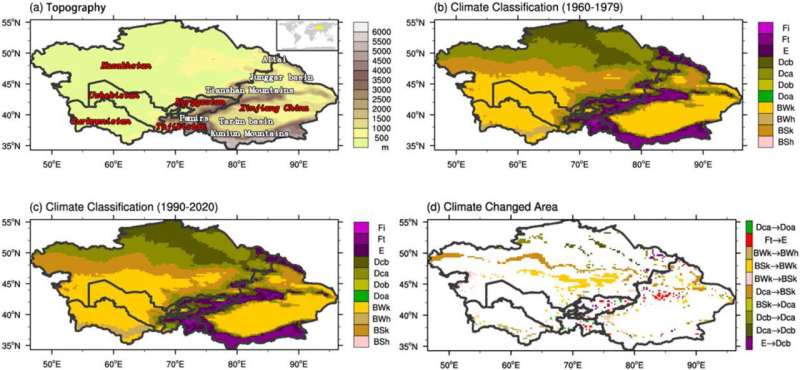June 23, 2022 report
Zone-by-zone study of Central Asia shows hotter and drier deserts and warmer and wetter mountains due to climate change

A pair of researchers at the University of Nebraska's School of Natural Resources and Department of Earth and Atmospheric Sciences has conducted a zone-by-zone study of weather in Central Asia to learn more about changing conditions under global warming. In their paper published in the journal Geophysical Research Letters, Qui Hu and Zihang Han describe how they separated the region into separate zones to get a more localized view of global warming impacts on the region.
As greenhouse gas emissions rise, scientists around the world are scrambling to better understand what a warmer world will look like. In this new effort, Hu and Han focused their efforts on Central Asia—a region that includes countries such as Uzbekistan, Kyrgyzstan, Kazakhstan and some western parts of China. Most of Central Asia is dry and a lot of it is desert. Prior research has shown that as the region warms, it is also growing drier, suggesting that parts of the region will eventually become uninhabitable.
In this new effort, the researchers noted that most research into climate change in Central Asia has focused on the region as a whole, which does not contribute to local mitigation efforts. To rectify that situation, they divided the region into 11 climate zones and studied climate data for each of them to see what changes have occurred thus far and to predict, if possible, future changes.
In looking at the zones from a more localized perspective, the researchers found air temperature increased, some as much as 5 degrees Celsius on average, between 1990 and 2020. They also found that the desert regions have been growing, expanding both north and east, and that there is less rain falling in most of the zones. The researchers also found more precipitation in some of the eastern mountainous zones, but it has more often been rain rather than snow. The rising temperatures, along with increased rain, have accelerated the reduction of snow and ice at higher elevations.
More information: Qi Hu et al, Northward Expansion of Desert Climate in Central Asia in Recent Decades, Geophysical Research Letters (2022). DOI: 10.1029/2022GL098895
Journal information: Geophysical Research Letters
© 2022 Science X Network





















